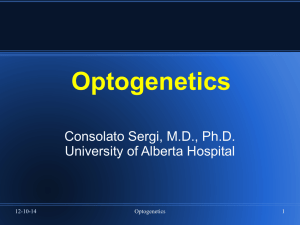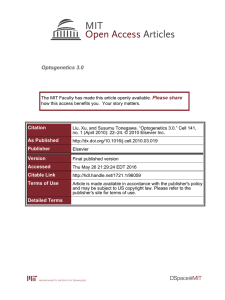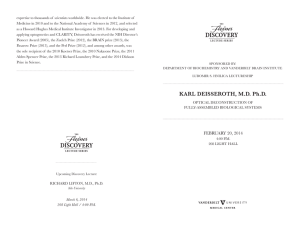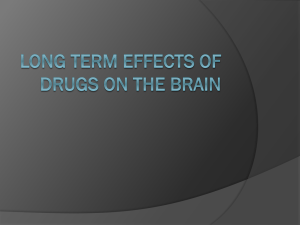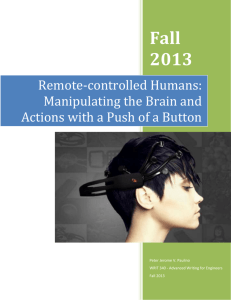Light Activation of Neurons
advertisement
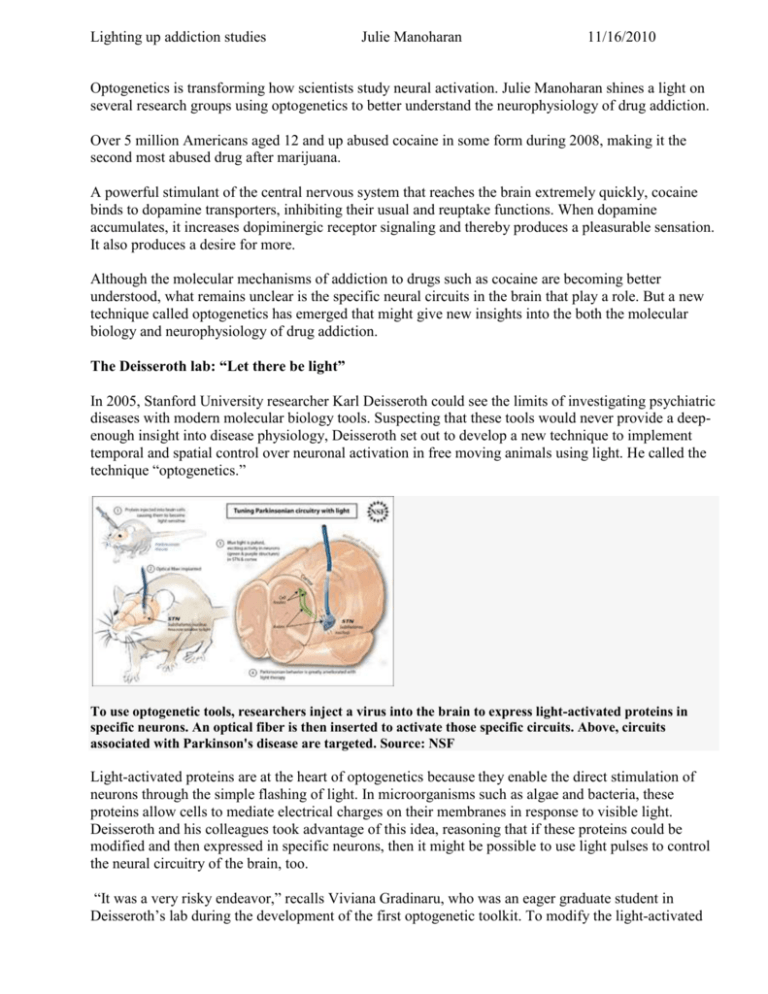
Lighting up addiction studies Julie Manoharan 11/16/2010 Optogenetics is transforming how scientists study neural activation. Julie Manoharan shines a light on several research groups using optogenetics to better understand the neurophysiology of drug addiction. Over 5 million Americans aged 12 and up abused cocaine in some form during 2008, making it the second most abused drug after marijuana. A powerful stimulant of the central nervous system that reaches the brain extremely quickly, cocaine binds to dopamine transporters, inhibiting their usual and reuptake functions. When dopamine accumulates, it increases dopiminergic receptor signaling and thereby produces a pleasurable sensation. It also produces a desire for more. Although the molecular mechanisms of addiction to drugs such as cocaine are becoming better understood, what remains unclear is the specific neural circuits in the brain that play a role. But a new technique called optogenetics has emerged that might give new insights into the both the molecular biology and neurophysiology of drug addiction. The Deisseroth lab: “Let there be light” In 2005, Stanford University researcher Karl Deisseroth could see the limits of investigating psychiatric diseases with modern molecular biology tools. Suspecting that these tools would never provide a deepenough insight into disease physiology, Deisseroth set out to develop a new technique to implement temporal and spatial control over neuronal activation in free moving animals using light. He called the technique “optogenetics.” To use optogenetic tools, researchers inject a virus into the brain to express light-activated proteins in specific neurons. An optical fiber is then inserted to activate those specific circuits. Above, circuits associated with Parkinson's disease are targeted. Source: NSF Light-activated proteins are at the heart of optogenetics because they enable the direct stimulation of neurons through the simple flashing of light. In microorganisms such as algae and bacteria, these proteins allow cells to mediate electrical charges on their membranes in response to visible light. Deisseroth and his colleagues took advantage of this idea, reasoning that if these proteins could be modified and then expressed in specific neurons, then it might be possible to use light pulses to control the neural circuitry of the brain, too. “It was a very risky endeavor,” recalls Viviana Gradinaru, who was an eager graduate student in Deisseroth’s lab during the development of the first optogenetic toolkit. To modify the light-activated Lighting up addiction studies Julie Manoharan 11/16/2010 proteins for expression in mammalian brains, it required a significant amount of capital without any guarantee of success. “Most likely this shouldn’t have worked, but the experiment was extremely successful. It was very exciting and impressive,” she says. To deliver these modified proteins, the researchers inject a virus containing the coding sequence of the light-activated channel into the brain of the subject—usually a mouse or rat. The virus is designed to target specific neurons, and once infected with the modified light-activated protein code, these neurons begin expressing the light-sensitive protein. An optical fiber is then implanted into the target brain area to provide the necessary light stimulation. Once the optical fiber in implanted, neurons can be stimulated with blue light or inhibited with yellow light depending on the light-activated channel transfected into the neuron. Most impressive might be that the light can target neurons on the millisecond timescale, a level of precision previously not available to neurobiologists. What has been particularly exciting about the technique, according to Gradinaru, is how easy it is. As a graduate student, she completed her first optogenetics experiment after only one week of training, and Gradinaru says that the ease of use gave their approach a competitive edge over others working in optogenetics. Since finding its way into the spotlight, Deisseroth has collaborated with many researchers from around the world, teaching hundreds how to use the tool. The lab has published 37 papers outlining potential uses of optogenetic tools for research on sleep behavior, Parkinson’s disease, motor control, and escape behavior. But most recently, optogenetics has been lighting up drug addiction studies, giving researchers the means to look at specific circuits in the brain involved with reward learning. Shining the spotlight on dopamine Antoine Adamantidis, a member of Stanford University’s Psychiatry and Behavioral Sciences Department, is one of Deisseroth’s many collaborators. Interested in further characterizing the role of dopaminergic neurons in reward and addiction, he wanted to know if activation of these neurons alone caused drug abuse behavior. But as Deisseroth had found in his own research, traditional research tools did not have the temporal and spatial precision to answer that question. For example, electrical stimulation activates both dopaminergic neurons and the surrounding neurons in the brain, making it unclear what exactly is contributing to the behavior. His research often came up on dead-ends or too-general results, and it wasn’t until optogenetics that he found the tool to help him answer his question. “You can really manipulate, as you want, the activity of neurons. You can activate them, inhibit them, with very high precision,” says Adamantidis. Using optogenetics, Adamantidis was able to control the stimulation of the dopaminergic neurons of mice while they explored two chambers: one white, the other black. While mice were in the white chamber, his research team stimulated the mice’s dopaminergic neurons with 1 Hz of blue light. While mice were in the black box, they used 50 Hz. In the end, the mice showed a preference for the black box, suggesting that dopamine alone is enough to induce reward behavior. “It is a really promising technique,” says Adamantidis. “It’s also really fun to play with in the lab, just because it’s so impressive.” Lighting up addiction studies Julie Manoharan 11/16/2010 Illuminating dopamine receptor subtypes Stanford’s Antoine Adamantidis found that after optogenetic dopamine circuit stimulation during a visit to one chamber, mice preferred that chamber over two others wherein the circuit received either less stimulation or no stimulation at all. Five types of dopamine receptors—D1, D2, D3, D4, and D5—are involved in various neurological processes. Previous research has suggested that subtypes D1 and D2 have opposite roles in motor behavior, but their role in drug addiction has not been well characterized. This was a knowledge gap that Mary Kay Lobo, postdoctoral fellow at Mount Sinai Medical Center, decided to fill. “We wanted to see what happens when you actually activate [D1 and D2] during these behaviors, because there’s just no information on that,” says Lobo. The problem was that the D1 and D2 cells are located within the nucleus accumbens (NAc), an interior region of the brain to which researchers lacked adequate access in order to study the specific roles of D1 and D2 cell subtypes. “The problem in the past has been that the cells are heterogeneously intermixed in the brain region and it’s been hard to separate them,” says Lobo. “Now we have these nice tools to separate them.” These “nice tools” are the optogenetic tools that allowed Lobo and her colleagues to activate D1 and D2 cell subtypes separately in mice while they experienced a cocaine response. In her experiment, Lobo presented mice with two chambers and conditioned them to prefer one over the other by rewarding them with cocaine in one chamber. Then they introduced their optogenetic tools. With the mice conditioned to prefer the cocaine chamber over the other chamber, Lobo’s group activated the D1 receptors. The mice returned to the cocaine chamber more frequently, increasing their level of addiction. When the researchers activated the D2 receptors, the mice spent less time in the cocaine chamber. That means that D1 and D2 dopamine receptor subtypes play opposite roles in the expression of reward in cocaine response. D1 receptors activate reward behavior, while D2 receptors inhibit reward behavior. “The findings suggest that future therapies aimed at changing the activity of the D2 neurons, making them more active, might help to decrease a cocaine-addictive phenotype,” said Lobo. Lighting up addiction studies Julie Manoharan 11/16/2010 Radiating relapse Luis de Lecea, a professor of psychiatry and behavioral science at Stanford University and another frequent collaborator of Deisseroth’s, has worked extensively with optogenetics in numerous fields including sleep behavior and drug addiction. Recently, he has applied the technique to better understand relapse behavior. “Optogenetics allows us to define the circuits much more precisely than before and that can lead to better treatment for drug abusers,” Lecea told BioTechniques. To test his theory that hypocretins—a pair of excitatory neuropeptide hormones—are involved in the pleasurable response delivered by the brain during relapse, Luis designed an experiment wherein previously addicted mice had the choice of two levers. One lever optogenetically stimulated the hypocretin circuit; the other did nothing. The mice preferred the lever that activated the hypocretin circuit, and their drug seeking behavior returned, suggesting hypocretin contributes to relapse behavior. Left: Optical fibers target the nucleus accumbens (NAc) in the mouse brain. Right: Optogenetic tools allow extreme temporal precision: NAc firing is controlled on a milisecond timescale. “We are really using optogenetics at its best,” Lecea said. “The cell specificity and fine temporal resolution are really unprecedented in vivo.” Using their findings, Lecea believes that one day a treatment may be developed to inhibit the activity of hypocretin in humans, which would in turn inhibit the cravings in those addicted and reducing the risk of relapse. A burgeoning technique already showing promise across a variety of disciplines, optogenetics is primed to answer some exciting questions about neural circuits and behavior. “It can really answer some big questions in the field, and it can open our eyes to new perspective and a new way of testing the hypotheses we have,” Adamintidis reflected. “The funny thing about optogenetics is that we have to rethink the whole way we were considering neuronal behavior. We can now read behavior on a millisecond timescale. Our tools are just so much better.”

